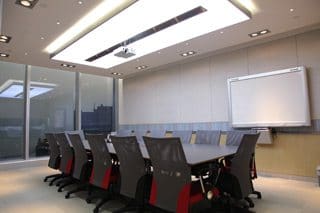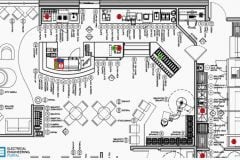
Human beings need to be informed about their surroundings in order to perform their activities in an easy and harmless fashion. Most information about the environment reaches human beings through their eyes. Therefore, it is of a visual nature.
The term visibility (of an object) is used as a measure of easiness, fastness and precision an object may be detected and visually recognized. In consequence, a good visibility of the surrounding environment, and everything it contains, is essential.
Good lighting is required for good visibility. Although good visibility of relevant objects is a necessary condition, it is not always enough to perform activities easily and comfortably. In indoor areas, where a task is performed, the main function of lighting is to provide comfort for visual tasks in this place.
Thus, the most important criteria related to lighting design for a particular application are visibility and visual satisfaction. Moreover, such factors must be well balanced in relation to installation and working costs.
Visibility / visual performance
Working in indoor areas, the influence of lighting while doing the job is very important. Performance for a specific person, for a concrete job, is esencially translated into a function of the person’s ability to perform a task (execution potential), on the one hand. On the other hand, the person’s attitude towards the task execution (execution
attitude) is also relevant.
Attitude during execution determines, to what extent, the execution potential is efficiently used. It includes factors such as motivation, dedication and concentration, of a social or psychological nature, and which lie outside our field of study. Lighting, as well as other factors in the physic environment, may influence the execution potential, but, influence on real execution also depends on the execution attitude. Visual performance is the term used to describe the eye working speed and the accuracy with which a task is performed.
Visibility of a task is generally determined by visibility of the most difficult element which must be detected or recognized so that work can be performed. This detail is known as critical detail. Visibility of the critical detail is a function of the difficulty experienced in order to discriminate it visually from the background on which it is seen, from other details found in its most immediate surroundings.
Luminance
In order to achieve good visibility at work, the most important factor is related to luminance of the task and its surroundings. The general effect of luminance on visibility is due to the resulting adaptation, process by which properties of the visual system are modified according to luminances of the visual field. For a given luminance distribution in the visual field, the adaptation process reaches a final state expressed as adaptation luminance.
Visual system properties affected by adaptation to luminance are the following:
- Visual sharpness, which is the capacity of the system to discriminate between details or objects that are very close.
- Sensitivity to contrast, which is the capacity of the system to distinguish between small differences of relative luminance.
- Efficiency of eye motor functions for accommodation, convergence, pupil contraction, eye movements, etc.
Visual sharpness, sensitivity to contrast and efficiency of eye motor functions are larger with the increase of adaptation luminance up to a maximum certain level.
For tasks where detail angular size is critical with respect to working visibility, an increase in visual sharpness due to another increase in luminance is highly important to improve task visibility. However, when the angular size of the critical size is very much above the threshold of visual sharpness, contribution to its increase is insignificant.
Something similar happens with the above mentioned factors. They may also be positively affected by an increase in luminance. However, it will provide an improved visibility at work as a result, as long as such factors are critical with respect to visibility of the task under consideration.
Diffusing objects and their surroundings
Luminance of a matte surface is proportional to the product of illuminance in the surface and its reflectance. Luminance as a factor that influences visibility may be, in consequence, substituted by illuminance and reflectances for diffusing surfaces and their surroundings. Reflectances form part of the intrinsic properties of the task and the indoor area. These are not affected by lighting. Thus, for these tasks only illuminance remains a factor of the lighting system which affects visibility. It should be born in mind that for these tasks, luminance contrast is not affected by illuminance, but it is determined by reflectances of details and their background. Therefore, task visibility will be larger with the increase in illuminance up to a maximum certain level.
The effect of the illuminance increase over visibility will be larger as size is smaller, or the contrast detail or the number of exigencies of the eye motor functions. For details of large angular size, with a high contrast with the background and static in a known position, the effect of illuminance increase in visibility on a moderate level will be insignificant.
Bright objects and their surroundings
Considering that luminance of a perfectly matt object is proportional to the product of illuminance and reflectance (diffuse), luminance of a regular reflecting surface is proportional to the product of its reflectance (regular) and the environmental luminance in the reflection direction.
In practice, however, most surfaces do not belong either to the perfectly diffused reflection or to the perfectly regular one. Surfaces have mixed reflection properties in such a way that their luminance depends both on the illuminance properties of the surface as well as on the luminances of the surroundings. In order to relate luminance of mixed reflection surfaces with illuminance in a similar way as luminance of a matt surface is related to illuminance by its reflectance, the luminance factor has been introduced.
Luminance factor of a surface in a given direction under certain lighting conditions, is the reason for the surface luminance in that direction to the luminance of a perfectly diffusing white surface, when they are identically illuminated.
From this definition, it may be deduced that the luminance factor of a perfectly diffusing surface is constant and equal to its reflectance in all directions and under all lighting conditions. In an environment of uniform luminance L, luminance of a perfectly regular reflecting surface is L in all directions and luminance of a perfect diffusing white surface is also equal to L.
Luminance factors of that regular reflecting surface under such lighting conditions, are equal to 1 in all directions. In an environment of luminance equal to 0 except for a limited L luminance area (source), luminance of a perfect diffusing white surface is smaller than L because illuminance is lower than illuminance in an environment of uniform luminance L.
Luminance factor of such regular surface, thus, is larger than 1 in the directions of reflection of the source and 0 in all other directions. Since bright surfaces have reflection properties partly regular and partly diffused, it may be deduced from all the above that for such mixed reflection surfaces, luminance factor will be constant and equal to its reflectance (mixed) in all directions only in a uniform luminance environment. In other environments, it may reach values between 0 and above 1, depending both on reflection properties and lighting systems.
This also means that contrasts in objects which are not perfectly matt are affected by lighting because they are determined by luminance factors of details and background. These may reach different values in different visual directions, especially in directions of high luminance reflection.
In conclusion, for tasks and bright contours not only illuminance is important for good visibility but also lighting direction. This is a general term which describes the special distribution of incident light in the task. It is determined by luminance distribution of the environment and depends on factors such as geometry of installation, luminances of luminaires and indoor reflectances.










